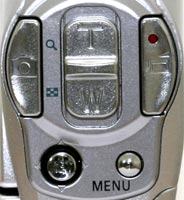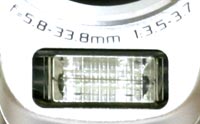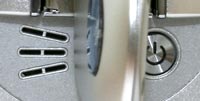Sanyo Xacti C1
(known as the Fisher FVDC1 CameraCorder in the USA)
Review Date: November 20th 2004
|
Ease of Use
The Sanyo Xacti C1 is by far and away the most stylish and unique digital camera that I have reviewed. It has a futuristic, upright design that sets it apart from most other cameras available today, one which I think you will either instantly love or instantly hate. The C1 will definitely appeal to anyone who likes cutting edge gadgets. The nearest camera that I can think in terms of looks are the portrait format Fuji cameras (I have reviewed the Finepix F610) which are a lot less curvy than the C1.
The camera is made of a shiny silver plastic and is just about small enough to fit into a trouser pocket. The lens is protected by a plastic cap that snaps onto the front of the camera. This can be attached to the camera using the eyelet at the bottom and the supplied cord. The lens itself is the non-protruding kind that doesn't extend or retract. The camera is very well-made, with nothing that feels as though it will fall off given enough wear and tear. The only thing that I wasn't overly fond of was the memory card cover, which hangs down by a fragile looking plastic hinge when you open it. The tripod mount is only made of plastic, but Sanyo have done well to include one at all given the very small footprint of the camera.
The Sanyo Xacti C1 is a fairly heavy digital camera, despite being small in terms of its dimensions, weighing 175g when batteries and storage card are fitted. I think this actually counts in its favour, as it has a reassuring balance and weight to it without being too heavy, which is quite important given its upright format and the fact that you tend to hold it one-handed a lot of the time.
The Sanyo Xacti C1 operates more like a miniature camcorder than a conventional stills camera, with it's flip-out, rotating LCD screen and upright format. I found it strange and clumsy to use during the first few days of reviewing it, but gradually the C1 started to grow on me. The LCD screen is great for candids, as you can hold the camera at waist level and still accurately frame pictures. The upright format soon became second nature too - I held the camera in my right hand and gripped the LCD screen with my left hand to steady the camera. The main useability issue that I had with the Sanyo Xacti C1 was the shutter release buttons (there are two of them, one for still images and one for movies). They naturally sit under your right thumb. I found it very unintuitive using my thumb to operate the shutter after all these years of using my right forefinger! And I'm still not convinced that it's a great way to capture the moment. Thankfully Sanyo have at least provided large shutter release buttons which should accommodate the largest of thumbs!
| Shutter Button (still) / Zoom Switch / Shutter Button (movie) Set Button / Menu Button | Flash Unit |
 |
 |
The zoom switch also follows the vertical format of the camera - you push it up to zoom in, and pull it back to zoom out. Again this takes a little time to familiarise yourself with. Sanyo have done an excellent job in designing a camera that doesn't have too many buttons and switches to confuse you. There are just 6 external controls in total, with all of them are clearly labeled and understandable. As mentioned above, the shutter buttons are large and tactile, as are the zoom switch and the REC/Play switch. The two controls that I liked less were the small menu and Set buttons. The Set button in particular is too small and fiddly to operate, given that you use it to select menu options and review your pictures. This control could definitely be improved on any future version of the camera.
The Sanyo Xacti C1 has a very clever way of powering on and off. When you first open the box and hold the camera, you may wonder how to actually turn it on! Simply open the fold-out LCD screen and all is revealed; underneath on the side of the camera is a small silver on/off button. Even cleverer is the fact that if you forget to turn this off and you close the LCD screen, the camera will automatically be turned off anyway. No more wasting vital battery power because you forgot to press the right button.
The menu system of the Sanyo Xacti C1 isn't quite as well designed as the exterior of the camera. At the left-hand side of the menu system is a semi-circle with a coloured segment and a capital letter (either B or E). Pressing left or right on the Set button selects either of the segments, with each one representing a menu - Basic Menu or Expert Menu. I've not seen this menu structure before and I'm not convinced that it is as intuitive as a tabbed interface, for example. The Expert Menu contains nearly every available option, whilst the Basic Menu contains a subset of the options. I just set it to Expert and ignored Basic. Even in the Expert setting there aren't that many options, so I would have liked to see a single unified menu system.
So what is the Sanyo Xacti C1 like to actually operate and take a photo? Despite the camera having a non-protruding lens, the start-up time from turning the camera on to being ready to take a photo is actually quite slow, because you have to hold down the On/Off button for about 1 second to power the camera on. Thankfully it takes a snappier 0.5 seconds to zoom from the widest focal length to the longest. Focusing is quick and responsive in good light thanks to the 5-point autofocus system, although performance is less responsive indoors or in low-light situations, as there is no Assist light. Both the refresh rate and visibility of the standard sized 1.5" LCD screen are good and it is visible even in bright sunlight. Images are stored quickly (around 1 seconds), but unfortunately the LCD screen blacks out whilst an image is being stored, preventing you from taking any more images. Also there is no continuous shooting mode available, so the Sanyo Xacti JC1 isn't really geared up for action shooting.
| Tripod Mount / Docking Cradle Connection | Microphone / On-Off Switch |
 |
 |
Once you have captured a photo, the Sanyo Xacti C1 has quite a lot of options when it comes to playing, reviewing and managing your images. You can scroll through the images that you have taken and play a slideshow with a choice of intervals. You can rotate an image, choose which images to Protect (to prevent them from being deleted), delete an image and zoom in and out. Finally, you can configure which images you want to print, setting the date and how many copies you want to print. You can also choose to print an Index Print of all images and edit a video clip. Perhaps the main missing playback function is a histogram, either before taking a photo or after, which would make evaluating the exposure of a photo easier than by simply looking at it onscreen. This is a feature that is now found on many low-end digicams, so the Sanyo Xacti C1 loses out in this respect.
Sanyo are more than generous with the box contents of the Sanyo Xacti C1, providing both a docking cradle and a remote control. The cradle makes downloading images and recharging the camera very easy - simply plug it into a USB port on your computer, place the camera in the cradle and away you go. The remote control is also a very welcome included accessory, allowing you to control and fire the camera remotely. Well done Sanyo!
The Sanyo Xacti C1 is a very unique camera in terms of its design and format, so I would strongly advise that you try one out for yourself before buying one. There are a few niggly points, the worst one probably being the 1 second LCD blackout between shots, but overall the Sanyo Xacti C1 gets most things right.
|
 PhotographyBLOG is a member of the DIWA organisation. Our test results for the Sanyo Xacti VPC-C1 have been submitted to DIWA for comparison with test results for different samples of the same camera model supplied by other DIWA member sites.
PhotographyBLOG is a member of the DIWA organisation. Our test results for the Sanyo Xacti VPC-C1 have been submitted to DIWA for comparison with test results for different samples of the same camera model supplied by other DIWA member sites.
